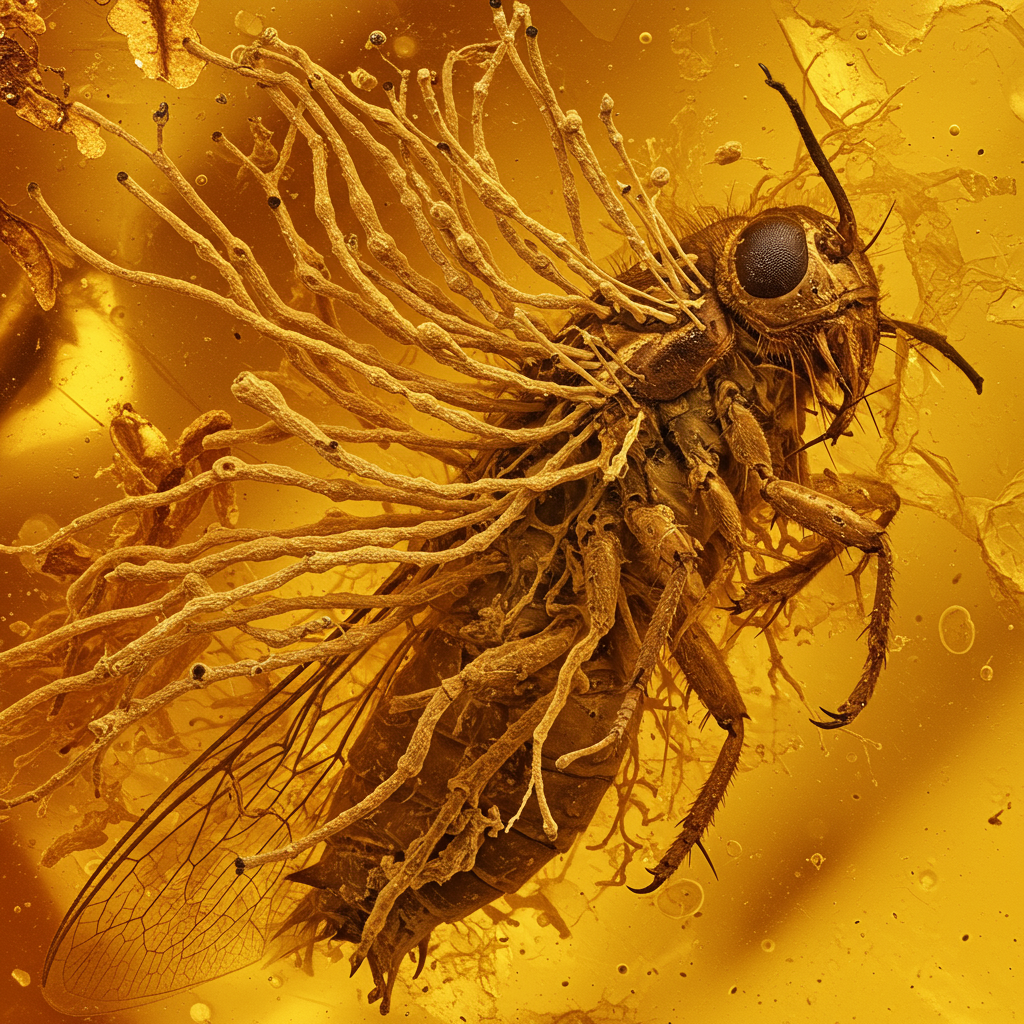Imagine a scene frozen in time, a dramatic moment of life and death captured for eternity. That’s exactly what scientists have uncovered: incredibly rare fossils of ancient parasitic fungi, often called “zombie” fungi, caught in the act of bursting from their insect victims almost 100 million years ago.
Preserved within stunning pieces of amber from Myanmar, these remarkable finds offer a chilling glimpse into the prehistoric world during the late Cretaceous period. Dating back to roughly 99 million years ago, these specimens provide some of the oldest direct evidence of this specific, often-horrifying host-parasite relationship.
Ancient Parasites Revealed
Amber, formed from the sticky resin of ancient trees, is a natural time capsule renowned for preserving delicate biological interactions that would otherwise vanish. Using advanced techniques like detailed microscopy and 3D micro-CT scans, researchers were able to study the intricate details of these tiny, ancient organisms.
The discovery includes two particularly striking examples, now housed at the London Natural History Museum:
A new species, Paleoophiocordyceps gerontoformicae, is seen with tiny, thread-like spore stalks emerging from the body of a pupating ant.
Another new species, Paleoophiocordyceps ironomyiae, features a distinct, singular fruiting body protruding directly from the head of a fly.
These moments, frozen in resin as the insects likely lay already dead from the infection, vividly illustrate the final, gruesome stage of the fungal lifecycle.
A Deep Evolutionary History
These newly identified Paleoophiocordyceps species share striking morphological traits with their modern-day relatives, the infamous Ophiocordyceps fungi. Today, Ophiocordyceps are notorious for their ability to infect insects, particularly carpenter ants, subtly manipulating their behavior – effectively turning them into “zombies.” The fungus might compel an ant to climb a plant stem and bite onto a leaf or twig, positioning the host optimally for the fungus to erupt and rain spores down onto unsuspecting insects below.
Scientists estimate that these ancient Paleoophiocordyceps lineages may have diverged from the main Ophiocordyceps group around 130 million years ago.
The fact that these 100-million-year-old fossils show the fungi already adapted to two different insect hosts – an ant and a true fly – is particularly significant. This suggests that the sophisticated parasitic strategy, including host specificity and behavioral manipulation (implied by the fruiting body location), was already well-established deep in evolutionary history.
According to paleoentomologist Edmund Jarzembowski, this ancient adaptation to multiple hosts indicates that the fungi’s ability to infect different insect groups likely evolved alongside major ecological shifts of the time. The diversification of flowering plants during the Cretaceous period led to a subsequent explosion in new insect groups, like moths and butterflies, providing new potential hosts for these adaptable fungi.
While ants appear to have been targeted by “zombie” fungi relatively early and remain common hosts today, finding a fly infected by this specific type of fungus is quite unusual in modern Ophiocordyceps cases, making the fossilized P. ironomyiae particularly noteworthy.
This rare discovery in amber underscores that the bizarre and complex natural world we observe today, including intricate host-parasite relationships, has roots stretching back tens of millions of years, long before humans walked the Earth. The research detailing these findings has been published in the scientific journal Proceedings of the Royal Society B.




